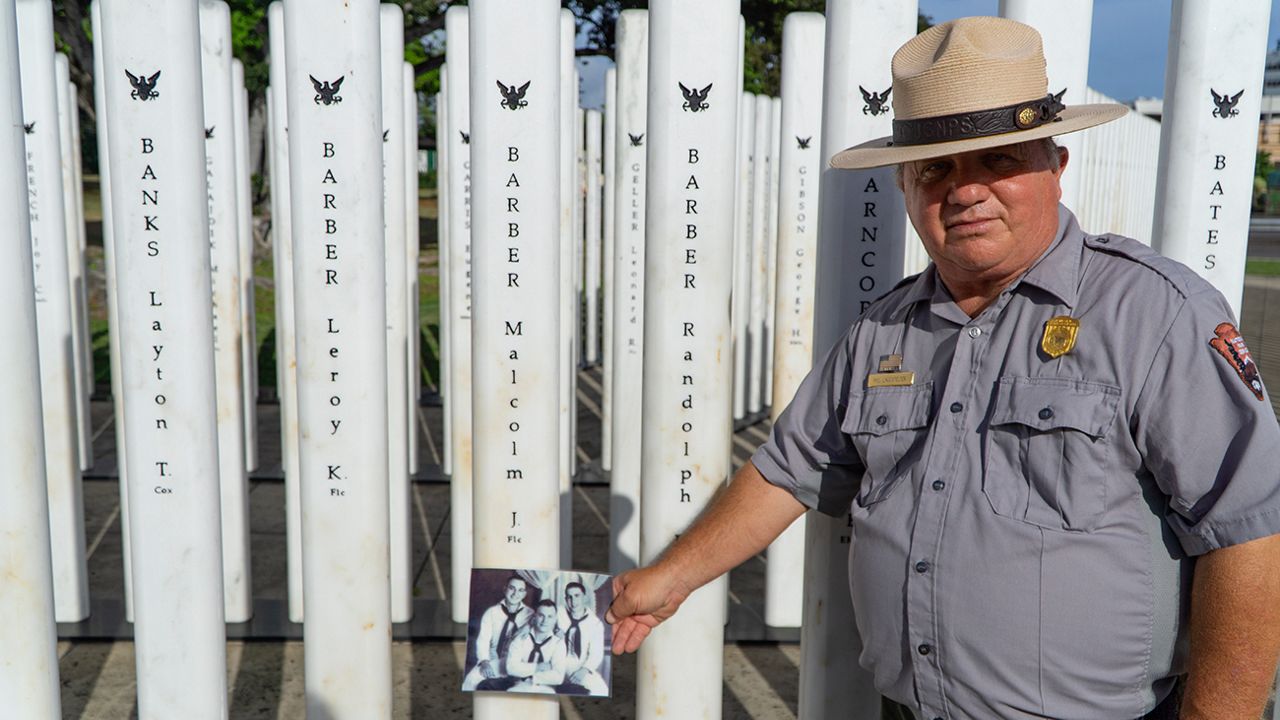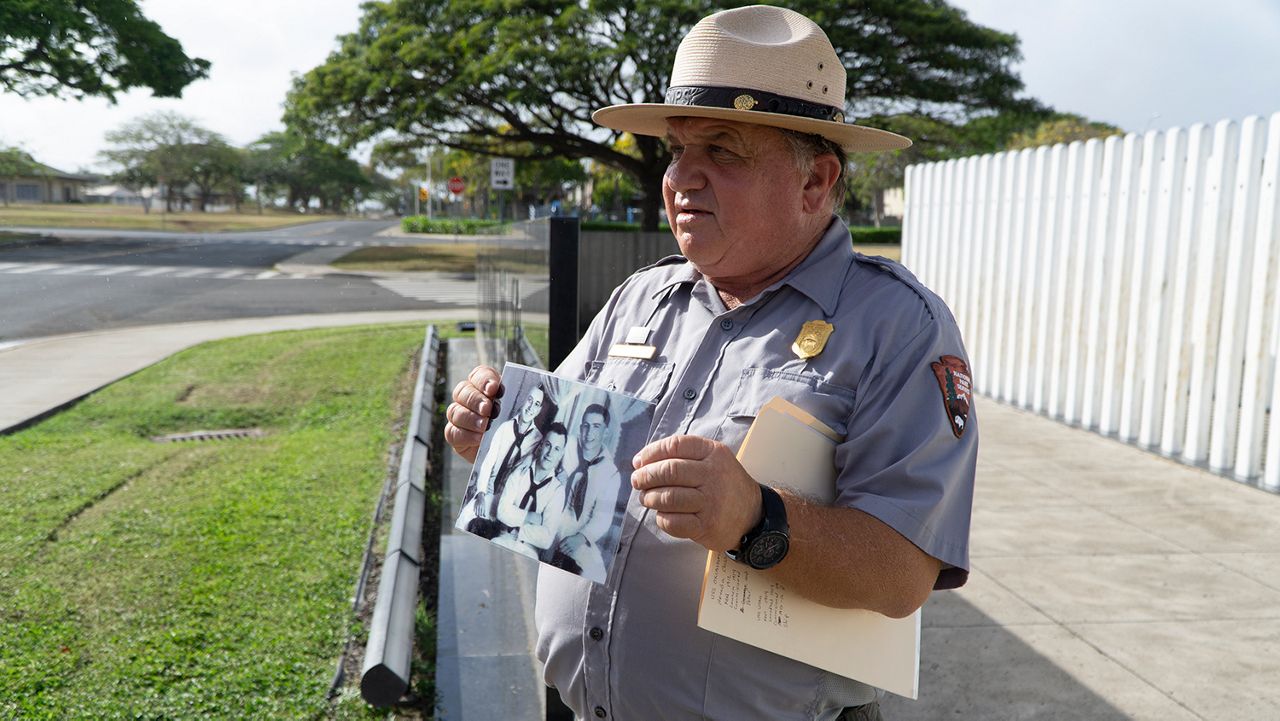PEARL HARBOR, Hawaii — The National Park Service announced new bus tours to the USS Utah and USS Oklahoma Memorials on Ford Island will begin May 9.
Visitors regularly spend time at the Battleship Missouri Memorial and Pearl Harbor Aviation Museum on Ford Island as part of the overall Pearl Harbor experience. Now, instead of shuttling past the group of white pillars that solemnly mark the USS Oklahoma Memorial on the way to the Missouri Memorial, and actually being able to visit the USS Utah Memorial on the northwest side of Ford Island, visitors on the new bus tour will hear the stories of the sailors and Marines who were killed on those respective battleships on Dec. 7, 1941. Countless are the stories of individuals on which to reflect and honor.
National Park Service Ranger Phil Lingenfelter is an avid reader and film buff, and he has those stories to share.
A week before the Dec. 7, 2019 commemoration, a woman named Margo stepped up to the information desk where Lingenfelter sat and said she knew nothing about her grandfather except that he had died aboard the USS Arizona. His name was Simon Romano.
“I immediately grabbed the book, ‘Men of Arizona,’ and looked up her grandfather’s name. Not only was his file in the book, there was a photograph,” shares Lingenfelter. “I showed it to her, and she took a photo of it. She and I actually went out to the memorial, and one of my all-time favorite photos is a photo of Margot kneeling by her grandfather’s name on the Arizona wall.”
Lingenfelter later mentioned the encounter with World War II Foundation’s Historian-in-Residence Daniel Martinez. Martinez called him to his office 15 minutes later. Lingenfelter learned about the history of Simon Romano, who, as an Officer’s Cook First Class, answered to only one individual on the USS Arizona — Commanding Officer Captain Franklin Van Valkenburgh, the battleship’s last captain.
A letter written by Romano to his wife back home in Long Beach, California, especially touched Lingenfelter. “I picked it up and started to read the letter,” he said. “The impression I got of this couple is here’s a couple, just like anybody else struggling to pay their bills. He’s tried to send money to her on the Pan Am Clipper, and there’s a ring he bought her that I guess in a previous letter, she was asking him to mail to her. And he’s telling her ‘no,’ the ship is going to be on the West Coast for Christmas. ‘I want to be able to put in your finger.’”
Simon Romano’s wife, Margo’s grandmother, never received the letter dated Dec. 6, 1941.
Martinez and Lingenfelter mailed hard copies of Romano’s file to Margo in Australia. “And now she can share that with the rest of the members of the family.”

Launched on Dec. 23, 1909, and commissioned on Aug. 31, 1911, the USS Utah and its crew witnessed the U.S. occupation of Veracruz in 1941 during the Mexican Revolution, and was stationed at Berehaven, Ireland, after the U.S. entered World War I. The Utah conducted training cruises and fleet maneuvers, and toured South America with dignitaries onboard through the 1920s. In 1931, it was demilitarized and converted into a target ship and re-designated as AG-16.
On the morning of Dec. 7, the Utah was in Pearl Harbor. Two torpedoes hit it in the first few minutes of the attack, quickly flooding and rolling over the battleship. Most of its crew escaped except for 58 men.
Dedicated on Memorial Day in 1972, the USS Utah Memorial is a simple, white L-shaped platform that sits near the ship’s sunken remains. Two buoys mark the bow and stern.
Lingenfelter relates the story of Chief Yeoman T.D. Wagner and his wife. The couple had had twins, one of whom had passed away at birth. “He got reassigned to the USS Utah. Now, what he and his wife wanted to do was give his baby girl a burial at sea, and were awaiting the arrival of a proper chaplain being assigned to the USS Utah.” Then the attack took place. Wagner survived, but his baby’s ashes had been in his footlocker aboard the ship. Navy divers attempted to reach the locker, but could not.
“But you know what Chief Wagner said? He said, ‘That’s okay.’ He couldn’t think of anything better than to have his fellow shipmates guarding his baby girl for the rest of eternity.”
One might say that the Battleship Missouri Memorial steals the attention of visitors away from the USS Oklahoma Memorial with its striking profile towering above nearby Pier Foxtrot-5. Even Lingenfelter describes the Missouri as one of “the baddest battleships ever to go to sea,” along with its sister battleships, the Iowa, New Jersey and Wisconsin. He himself admits the Missouri “got into his blood” when he worked there about 20 years ago.
The USS Oklahoma Memorial, however, has its own stories to tell.

The USS Oklahoma was the 37th battleship to be commissioned by the U.S. Navy in May 1916. During WWI, it protected convoys on the Eastern Seaboard, and cruised the Atlantic and Pacific Oceans and Mediterranean Sea during the years prefacing WWII.
After being transferred to the Pacific Fleet in October 1936, the Oklahoma moved to Pearl Harbor on Dec. 6, 1940. It took its final spot on Dec. 5, 1941 alongside its sister ships in what is now known as “Battleship Row.” It was hit by nine torpedoes, capsizing about 12 minutes after the first hit. The loss of the Oklahoma’s 429 sailors and marines was second only to the 1,100 lost aboard the USS Arizona.
Although Lingenfelter can share all the facts and figures of the battleships, he is most interested in the stories. This is no different.
“It was very common practice before WWII and during the war for brothers to serve aboard the same ship. It was basically that you wanted to have a brother with you,” he says. “Peter Barber and his wife, Gertrude, found out that their middle boy, Leroy, had talked their older boy, Malcolm and Randolph, their third boy, into joining the crew of the USS Oklahoma, because he felt it was good duty.
“The father was beside himself. He did not want all his sons serving on the same ship, and was on the verge of writing to the Secretary of the Navy to break them up. And guess what happens? Pearl Harbor happens.”
Lingenfelter explains that the parents “waited, waited and waited” to hear what had happened to their boys. It wasn’t until Valentine’s Day that they were notified that their boys were presumed dead aboard the Oklahoma.
“The week before Christmas, their mother got this photo of her boys who thought it would be a great present for their mother to have a photo of them in their dress whites for Christmas.”
On Feb. 2, the parents received official word that Malcolm, 22; Leroy, 21; and Randolph, age 19, were presumed dead aboard the USS Oklahoma.
The story of Pearl Harbor is the story of thousands of individuals who have lost their lives in service to the United States.
The 90-minute Ford Island Bus Tour adds another facet to the overall Pearl Harbor experience as the stories of those aboard the USS Utah and USS Oklahoma are shared with the greater public. Tours run Mondays, Wednesdays and Fridays, departing from the Pearl Harbor Visitor Center at 3:15 p.m.
The public can make reservations at recreation.gov that are required for all participants, including infants and children. Reservations are also non-transferable since the two memorials are located on Ford Island, an active-duty military installation.
For the rest of 2022, nonprofit partner Pacific Historic Parks will help keep the program’s tour reservation fees at a reduced cost. Reservations are $1 per person, which is charged and kept by recreation.gov; it’s not transferred to the National Park Service.
Participants will walk short distances on some uneven, grassy areas. Email PERL_info@nps.gov for accessibility needs.
The Ford Island Bus Tour doesn’t include access to the USS Arizona Memorial. Those reservations require separate reservations on recreation.gov.
Sarah Yamanaka is a digital journalist for Spectrum News Hawaii. Read more of her stories here.









GoogleStView_070702025)